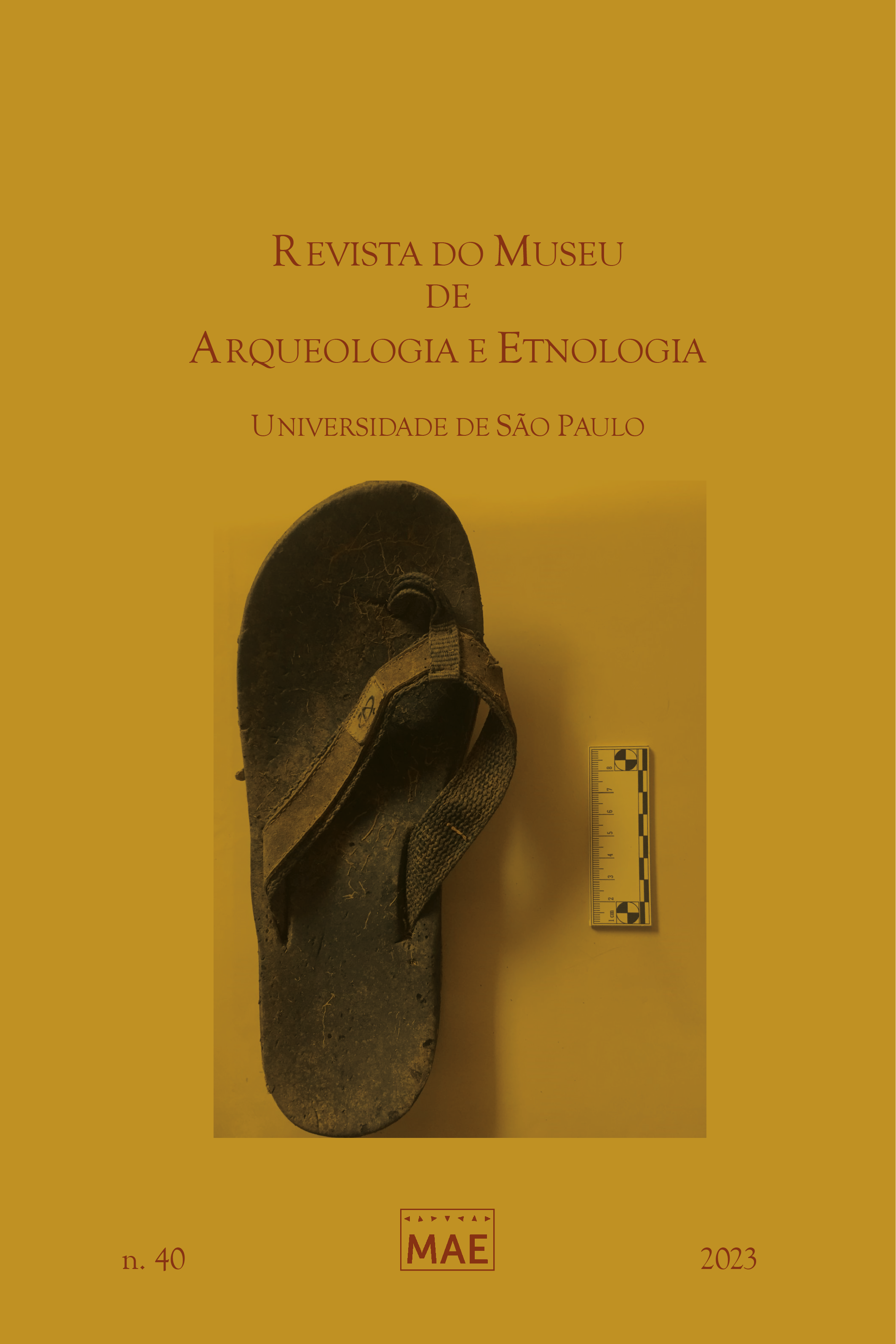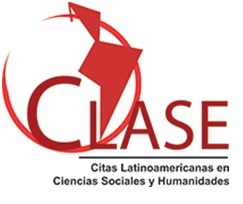A preservação de restos arqueobotânicos e o processo de análise por microtomografia de raios X
DOI:
https://doi.org/10.11606/issn.2448-1750.revmae.2023.187986Palavras-chave:
Microtomografia de raios X, Arqueobotânica, Preservação, Macrorrestos, Técnicas não destrutivasResumo
O uso de microtomografias de raios X para o estudo de restos macroscópicos de plantas recuperadas em sítios arqueológicos é uma prática relativamente recente em Arqueologia. No entanto, a técnica possui amplo espectro de aplicações em áreas de pesquisa muito diversas. Os diferentes trabalhos relacionados com a aplicação apontam a não destrutividade dos procedimentos microtomográficos como um de seus atributos relevantes, juntamente com a alta qualidade de discriminação das imagens tridimensionais geradas no processo. Este trabalho explora a importância dessa característica da microtomografia em relação a diferentes aspectos do estudo e da preservação dos macrorrestos arqueobotânicos. Ao preservar a integridade e habilitar a reanálise dos objetos examinados, a microtomografia de raios X permite otimizar a qualidade dos resultados e expandir a gama de técnicas analíticas aplicadas em seu estudo. Essa vantagem manifesta-se tanto na pesquisa em curso como naquelas que podem ser desenvolvidas no futuro sobre os mesmos objetos, usando técnicas e abordagens novas ou melhoradas. Além da preservação do objeto físico, a microtomografia providencia réplicas virtuais tridimensionais que podem ser utilizadas com finalidade analítica ou como respaldo da informação gerada. Aliás, esses modelos digitais apresentam grande adaptabilidade aos mecanismos de compartilhamento e disponibilização de dados de pesquisa, assim como podem ter efeitos notáveis na ênfase do valor visual dos materiais arqueobotânicos.
Downloads
Referências
Appoloni, C.; & Cesáreo, R. 1994. Microscanning and microtomography with X-ray tubes. LFNATEC – Publicação Técnica do Laboratório de Física Nuclear Aplicada, 4(1). https://doi.org/10.13140/RG.2.2.23079.47527
Archilla, S.; Giovannetti, M.; Lema, V. (Comps.). 2008. Arqueobotánica y teoría arqueológica: discusiones desde Suramérica. Universidad de Los Andes, Facultad de Ciencias Sociales, Departamento de Antropología, CESO, Ediciones Uniandes.
Azeredo, S.R. et al. 2019. Analysis of precious metals from the tomb of the “Lady of Cao” by X-ray microtomography and digital radiography. X-Ray Spectrometry, 48(5): 499-504. https://doi.org/10.1002/xrs.3013
Barron, A.; Denham, T. 2018. A microCT protocol for the visualization and identification of domesticated plant remains within pottery sherds. Journal of Archaeological Science: Reports, 21: 350-358. https://doi.org/10.1016/j.jasrep.2018.07.024
Barron, A.; Pritchard, J.; Denham, T. 2022. Identifying archaeological parenchyma in three dimensions: Diagnostic assessment of five important food plant species in the Indo-Pacific region. Archaeology in Oceania, 57(3): 189-213. https://doi.org/10.1002/arco.5276
Baruchel, J. et al. 2000. Phase imaging using highly coherent X-rays: Radiography, tomography, diffraction topography. Journal of Synchrotron Radiation, 7(3): 196-201. https://doi.org/10.1107/S0909049500002995
Beck, L. et al. 2012. Checking collagen preservation in archaeological bone by non-destructive studies (Micro-CT and IBA). Nuclear Instruments and Methods in Physics Research Section B: Beam Interactions with Materials and Atoms, 273: 203-207. https://doi.org/10.1016/j.nimb.2011.07.076
Bello, S.M.; De Groote, I.; & Delbarre, G. 2013. Application of 3-dimensional microscopy and micro-CT scanning to the analysis of Magdalenian portable art on bone and antler. Journal of Archaeological Science, 40(5): 2464-2476. https://doi.org/10.1016/j.jas.2012.12.016
Boschin, F. et al. 2015. A Look from the Inside: MicroCT Analysis of Burned Bones. Ethnobiology Letters, 6(2): 258-266. https://doi.org/10.14237/ebl.6.2.2015.365
Calo, C.M. et al. 2020. A correlation analysis of Light Microscopy and X-ray MicroCT imaging methods applied to archaeological plant remains’ morphological attributes visualization. Scientific Reports, 10(1): 15105. https://doi.org/10.1038/s41598-020-71726-z
Calo, C.M. et al. 2019. Study of plant remains from a fluvial shellmound (Monte Castelo, RO, Brazil) using the X-ray MicroCT imaging technique. Journal of Archaeological Science: Reports, 26: 101902. https://doi.org/10.1016/j.jasrep.2019.101902
Carman, J. 2002. Archaeology and Heritage: An Introduction. A&C Black, London.
Coubray, S.; Zech-Matterne, V.; Mazurier, A. 2010. The earliest remains of a Citrus fruit from a western Mediterranean archaeological context? A microtomographic-based re-assessment. Comptes Rendus Palevol, 9(6-7): 277-282. https://doi.org/10.1016/j.crpv.2010.07.003
Duval, M.; Martín-Francés, L. 2017. Quantifying the impact of µCT-scanning of human fossil teeth on ESR age results: DUVAL and MARTÍN-FRANCÉS. American Journal of Physical Anthropology. 163: 205-212. https://doi.org/10.1002/ajpa.23180https://doi.org/10.1002/ajpa.23180
Furquim, L.P. (2018). Arqueobotânica e mudanças socioeconômicas durante o Holoceno Médio no sudoeste da Amazônia [Dissertação de Mestrado, Universidade de São Paulo]. https://doi.org/10.11606/D.71.2019.tde-30112018-102517Galante, D. et al. 2018. Aplicação de técnicas de análise síncrotron em arqueologia. Cadernos do LEPAARQ (UFPEL), 15(30): 277-289. https://doi.org/10.15210/lepaarq.v15i30.13522
Haneca, K. et al. 2012. X-Ray sub-micron tomography as a tool for the study of archaeological wood preserved through the corrosion of metal objects. Archaeometry, 54(5): 893-905. https://doi.org/10.1111/j.1475-4754.2011.00640.x
Immel, A. et al. 2016. Effect of X-ray irradiation on ancient DNA in sub-fossil bones – Guidelines for safe X-ray imaging. Scientific Reports, 6: 32969. https://doi.org/10.1038/srep32969
Jeffrey, S. 2014. Archaeological informatics. In: C. Smith (Ed.). Encyclopedia of Global Archaeology, Springer, New York, 332-334. https://doi.org/10.1007/978-1-4419-0465-2_1053
Johnston, R. et al. 2020. Evidence of diet, deification, and death within ancient Egyptian mummified animals. Scientific Reports, 10(1): 14113. https://doi.org/ 10.1007/978-1-4419-0465-2_1185
Joyce, R.A. 2003. The monumental and the trace: Archaeological conservation and the materiality of the past. In: Neville, A.; Bridgland, J. (Orgs.). Proceedings of the Conservation Theme: Of the past, for the future: Integrating Archaeology and Conservation. The Getty Conservation Institute, Los Angeles, p. 13-18.
Kahl, W.-A.; Ramminger, B. 2012. Non-destructive fabric analysis of prehistoric pottery using high-resolution X-ray microtomography: A pilot study on the late Mesolithic to Neolithic site Hamburg-Boberg. Journal of Archaeological Science, 39(7): 2206-2219. https://doi.org/10.1016/j.jas.2012.02.029
Lima, I. et al. 2007. Caracterização de materiais cerâmicos através da Microtomografia Computadorizada 3D. Revista Brasileira de Arqueometria, Restauração e Conservação, 1(2), 22-27.
Lourenço, M.C.; Wilson, L. 2013. Scientific heritage: Reflections on its nature and new approaches to preservation, study and access. Studies in History and Philosophy of Science Part A, 44(4): 744-753. https://doi.org/10.1016/j.shpsa.2013.07.011
Machado, A.S. et al. 2019. Analysis of metallic archaeological artifacts by x-ray computed microtomography technique. Applied Radiation and Isotopes: Including Data, Instrumentation and Methods for Use in Agriculture, Industry and Medicine, 151: 274:279. https://doi.org/10.1016/j.apradiso.2019.06.016
McBride, R.; Mercer, G.D. 2012. Assessing damage to archaeological artefacts in compacted soil using microcomputed tomography scanning. Archaeological Prospection, 19(1): 7-19. https://doi.org/10.1002/arp.426
Mizuno, S.; Torizu, R.; Sugiyama, J. (2010). Wood identification of a wooden mask using synchrotron X-ray microtomography. Journal of Archaeological Science, 37(11), 2842–2845. https://doi.org/10.1016/j.jas.2010.06.022
Murphy, C.; Fuller, D.Q. 2017. Seed coat thinning during horsegram (Macrotyloma uniflorum) domestication documented through synchrotron tomography of archaeological seeds. Scientific Reports, 7(1). https://doi.org/10.1038/s41598-017-05244-w
Nava, A. et al. 2017. Virtual histological assessment of the prenatal life history and age at death of the upper paleolithic fetus from Ostuni (Italy). Scientific Reports, 7(1), 9427. https://doi.org/10.1038/s41598-017-09773-2
Ngan-Tillard, D. et al. 2015. Under pressure: a laboratory investigation into the effects of mechanical loading on charred organic matter in archaeological sites. Conservation and Management of Archaeological Sites, 17(2): 122-142. https://doi.org/10.1080/13505033.2015.1124179
Noel, J. et al. 2005. Les collections muséographiques en 3D par microtomographie Rayons X. In: Virtual Retrospect 2005, nov. 2005, Biarritz, France. 80-84.
Obata, H.; Miyaura, M.; Nakano, K. 2020. Jomon pottery and maize weevils, Sitophilus zeamais, in Japan. Journal of Archaeological Science: Reports, 34(Part A): 102599. https://doi.org/10.1016/j.jasrep.2020.102599
Pearsall, D.M. 2016. Paleoethnobotany: A Handbook of Procedures (3. ed.). Routledge, Abingdon.
Radon, J. 1986. On the determination of functions from their integral values along certain manifolds. IEEE Transactions on Medical Imaging, 5(4): 170-176. https://doi.org/10.1109/TMI.1986.4307775
Rueden, C.T. et al. 2017. ImageJ2: ImageJ for the next generation of scientific image data. BMC Bioinformatics 18: 529. https://doi.org/10.1186/s12859-017-1934-z.
Schneider, C.A., Rasband, W.S., Eliceiri, K.W. 2012. NIH image to ImageJ: 25 years of image analysis. Nat. Methods 9: 671-675. https://doi.org/10.1038/nmeth.2089.
Salvo, L. et al. (2003). X-ray micro-tomography an attractive characterisation technique in materials science. Nuclear Instruments and Methods in Physics Research Section B: Beam Interactions with Materials and Atoms, 200: 273-286. Disponível em< https://bit.ly/41pKX6z>. Acesso em: 23/02/2023.
Stabile, S. et al. (2021). A computational platform for the virtual unfolding of Herculaneum Papyri. Scientific Reports, 11(1): 1695. https://doi.org/10.1038/s41598-020-80458-z
Stelzner, J.; Million, S. 2015. X-ray Computed Tomography for the anatomical and dendrochronological analysis of archaeological wood. Journal of Archaeological Science, 55: 188-196. https://doi.org/10.1016/j.jas.2014.12.015
Stock, S.R. (2008). Microcomputed tomography: Methodology and applications (1. ed). CRC Press, Boca Ratón.
Villagran, X.S. et al. 2019. Virtual micromorphology: The application of micro-CT scanning for the identification of termite mounds in archaeological sediments. Journal of Archaeological Science: Reports, 24: 785-795. https://doi.org/10.1016/j.jasrep.2019.02.035
Ward, I. et al. 2019. Synchrotron X-ray tomographic imaging of embedded fossil invertebrates in Aboriginal stone artifacts from Western Australia: Implications for sourcing, distribution and chronostratigraphy. Journal of Archaeological Science: Reports, 26: 101840. https://doi.org/10.1016/j.jasrep.2019.05.005
Watson, S. (2020). Archaeology, visuality and the negotiation of heritage. In: Smith, L. Waterton, E. (Orgs.). Taking Archaeology out of Heritage. Cambridge Scholars Publishing, Newcastle. p. 28-47.
Zong, Y. et al. 2017. Selection for Oil Content During Soybean Domestication Revealed by X-Ray Tomography of Ancient Beans. Scientific Reports, 7(1): 43595. https://doi.org/10.1038/srep43595
Downloads
Publicado
Edição
Seção
Licença
Copyright (c) 2023 Cristina Marilin Calo, Marcia A. Rizzutto

Este trabalho está licenciado sob uma licença Creative Commons Attribution-NonCommercial-NoDerivatives 4.0 International License.
Dados de financiamento
-
Fundação de Amparo à Pesquisa do Estado de São Paulo
Números do Financiamento 2016/12867-7


















